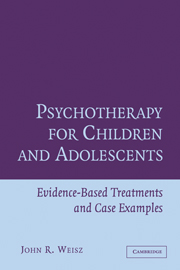Book contents
- Frontmatter
- Contents
- Preface
- SECTION A GENERAL INTRODUCTION
- SECTION B TREATMENTS FOR FEARS AND ANXIETY
- SECTION C TREATMENTS FOR DEPRESSION
- SECTION D TREATMENTS FOR ATTENTION DEFICIT/HYPERACTIVITY DISORDER
- SECTION E TREATMENTS FOR CONDUCT PROBLEMS AND CONDUCT DISORDER
- Introduction to Section E: The Case of Sal and Treatments for Conduct Problems and Conduct Disorder
- 8 Treating Conduct Problems by Teaching Anger Control
- 9 Behavioral Parent Training and Family Treatment for Conduct Problems
- 10 Parent-Child Interaction Treatments for Child Noncompliance
- 11 Parent Training through Video Modeling and Structured Group Discussion
- 12 Using Problem-Solving Skills Training and Parent Management Training for Children with Conduct Disorder
- 13 Multisystemic Therapy for Antisocial and Delinquent Youth
- SECTION F CONCLUSION
- References
- Author Index
- Subject Index
12 - Using Problem-Solving Skills Training and Parent Management Training for Children with Conduct Disorder
Published online by Cambridge University Press: 06 July 2010
- Frontmatter
- Contents
- Preface
- SECTION A GENERAL INTRODUCTION
- SECTION B TREATMENTS FOR FEARS AND ANXIETY
- SECTION C TREATMENTS FOR DEPRESSION
- SECTION D TREATMENTS FOR ATTENTION DEFICIT/HYPERACTIVITY DISORDER
- SECTION E TREATMENTS FOR CONDUCT PROBLEMS AND CONDUCT DISORDER
- Introduction to Section E: The Case of Sal and Treatments for Conduct Problems and Conduct Disorder
- 8 Treating Conduct Problems by Teaching Anger Control
- 9 Behavioral Parent Training and Family Treatment for Conduct Problems
- 10 Parent-Child Interaction Treatments for Child Noncompliance
- 11 Parent Training through Video Modeling and Structured Group Discussion
- 12 Using Problem-Solving Skills Training and Parent Management Training for Children with Conduct Disorder
- 13 Multisystemic Therapy for Antisocial and Delinquent Youth
- SECTION F CONCLUSION
- References
- Author Index
- Subject Index
Summary
One way to construe aggression and antisocial behavior is that they are ineffective ways of solving problems. Jared pushes Alex in the lunch line. Alex solves this problem by punching Jared in the face. This may seem effective in the short run, but it may also earn Alex an enemy for the rest of the school year, and it may cause some of Alex's peers to avoid him. Most likely it will get Alex into serious trouble at school. If he could suspend time for 15 minutes and think through all this before acting, Alex might come up with some alternative responses that are less risky. Unfortunately, Alex doesn't have 15 minutes to think it over, so he does what comes naturally, and fists fly.
Problem-Solving Skills Training (PSST), the treatment approach we consider in this chapter, is designed to teach aggressive youngsters to use their heads before using their fists. The children first learn basic steps of problem solving in the context of familiar games. The steps include defining the problem, identifying response options, and evaluating them. Then they learn to apply these steps to interpersonal situations, eventually including the kinds of situations that have led to aggressive behavior and prompted referral. If all goes well, the youngsters learn to apply their cognitive training during real-life stressful encounters, identifying and using increasingly prosocial solutions to their interpersonal problems.
PSST relies heavily on children's capacity to learn how to generate their own prosocial solutions to problems, although parents are also trained to help their children use the problem-solving steps.
Information
- Type
- Chapter
- Information
- Psychotherapy for Children and AdolescentsEvidence-Based Treatments and Case Examples, pp. 387 - 413Publisher: Cambridge University PressPrint publication year: 2004
